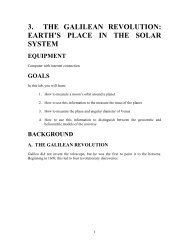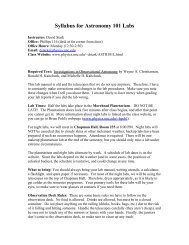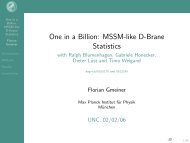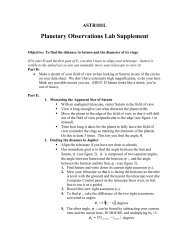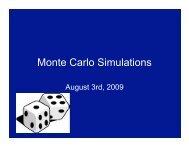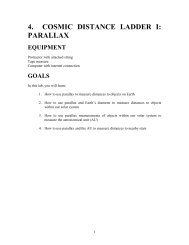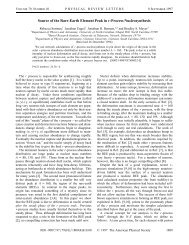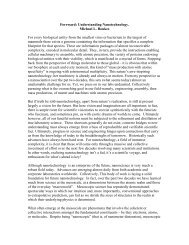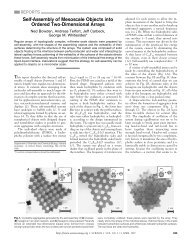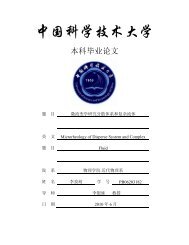Topics in Statistic Mechanics
Topics in Statistic Mechanics
Topics in Statistic Mechanics
Create successful ePaper yourself
Turn your PDF publications into a flip-book with our unique Google optimized e-Paper software.
<strong>Statistic</strong>al <strong>Mechanics</strong><br />
Advanced <strong>Topics</strong> and Applications<br />
Prof. Youj<strong>in</strong> Deng, my undergraduate Advanced <strong>Statistic</strong><br />
Physics Teacher, has signed us eight modern statistical<br />
mechanics topics for survey and <strong>in</strong>vestigation purposes.<br />
These topics, show<strong>in</strong>g <strong>in</strong> the text, is quite challeng<strong>in</strong>g to<br />
a student with limited knowledge of this vast area.<br />
Li, Zimeng<br />
3/17/2012<br />
Revised Version
<strong>Topics</strong> overview<br />
1. A brief survey of percolation. Please <strong>in</strong>clude the def<strong>in</strong>ition of the percolation<br />
model, its applications, exact solution on Cayley tree, and exact solution of the<br />
percolation threshold on the square lattice.<br />
2. Exact solution of the mean-field Blume-Capel model.<br />
Please locate the l<strong>in</strong>e of the phase transitions, which is consisted of a l<strong>in</strong>e of<br />
critical po<strong>in</strong>t, a tricritical po<strong>in</strong>t, and a segment of 1st order transition. Summarize<br />
the behavior of the energy density, the specific heat, the magnetization density,<br />
the susceptibility, the vacancy density, the compressibility near the transition<br />
l<strong>in</strong>e, and as a function of temperature 1/K. Derive critical exponents.<br />
3. Is<strong>in</strong>g model is an amaz<strong>in</strong>gly beautiful toy model <strong>in</strong> statistical mechanics. Please<br />
describe the exact solution of the Is<strong>in</strong>g model <strong>in</strong> 1D (<strong>in</strong>clud<strong>in</strong>g partition sum and<br />
all observable quantities), the exact solution of the critical po<strong>in</strong>t on the square<br />
lattice. Summarize theoretical exponent for d>1. Summarize its generalization to<br />
the Potts model (ord<strong>in</strong>ary and chiral). Can you locate the critical po<strong>in</strong>t of the<br />
ord<strong>in</strong>ary Potts model on the square lattice (us<strong>in</strong>g the duality relation)?<br />
4. 4, Quantum Is<strong>in</strong>g model plays an important role <strong>in</strong> quantum statistics. Its<br />
Hamiltonian is<br />
where sigma is the Pauli matrix. Please describe its phase transition. Us<strong>in</strong>g the<br />
path-<strong>in</strong>tegral language (Suzuki-Trotter formula), a d-dimensional quantum Is<strong>in</strong>g<br />
model can be mapped onto a (d+1) dimensional quantum Is<strong>in</strong>g model. Please<br />
derive this mapp<strong>in</strong>g.<br />
5. The classical XY model is frequently used to describe the universal behavior <strong>in</strong><br />
the phase transition between Mott-<strong>in</strong>sulator and superfluidity (or<br />
superconductivity). Please give reason<strong>in</strong>g why this is possible. Summarize the<br />
phase transition of the classical XY model <strong>in</strong> 1D, 2D, 3D, and more. Give the<br />
reason<strong>in</strong>g why the 2D XY model does not have long-ranged order<strong>in</strong>g at non-zero<br />
temperature (as rigorously as possible)—Merm<strong>in</strong>-Wagner theorem.<br />
6. In real worlds, we have bosons and fermions. By <strong>in</strong>terchang<strong>in</strong>g two of such<br />
particles, the phase of the wave function accumulates 0 and PI, respectively, for
osons and fermions. Their statistical behavior obeys the Bose-E<strong>in</strong>ste<strong>in</strong> and the<br />
Fermi-Dirac statistics, respectively. Please derive them. In some 2D systems with<br />
strong <strong>in</strong>teractions, however, the excitons—psedo-particles—do not obey either<br />
of the statistics. Interchang<strong>in</strong>g two excitons can lead to a phase change of any<br />
value between 0 and 2 Pi. Such pseudo-particles are named “anyons”. They are<br />
used expla<strong>in</strong> the quantum Hall effects as well as the recently discovered<br />
quantum Sp<strong>in</strong>-Hall effects, and are found to have profound implication <strong>in</strong><br />
quantum computation. Two beautiful models for anyons are the Kitaev model<br />
and the Wen model. Please give a survey of anyons and these two models.<br />
7. Def<strong>in</strong>e the renormalization group (RG) <strong>in</strong> the language of the G<strong>in</strong>zburg-Landau<br />
model. Expla<strong>in</strong> the universality by RG. Derive the Gaussian the fixed po<strong>in</strong>t and<br />
the associated critical<br />
8. Monte Carlo method is an important tool <strong>in</strong> researches, eng<strong>in</strong>eer<strong>in</strong>g, as well as <strong>in</strong><br />
<strong>in</strong>dustries. In particular, Markovian-cha<strong>in</strong> Monte Carlo (MCMC) method is found<br />
extensive applications <strong>in</strong> statistical physics. Please give a survey of MCMC.<br />
Design your own for the 2D Is<strong>in</strong>g model; calculate energy, density, specific heat,<br />
magnetization density, and susceptibility. Locate the critical po<strong>in</strong>t, and calculate<br />
the associated critical exponents.
Index<br />
Click the title below to go to the dest<strong>in</strong>ation chapter<br />
Homework 1 Percolation<br />
1. Def<strong>in</strong>ition<br />
2. Application<br />
3. Exact Solution on Cayley Tree<br />
4. Exact Solution on Square Lattice<br />
Homework 2 Blume-Capel Model<br />
1. Def<strong>in</strong>ition<br />
1.1 Tricritical Is<strong>in</strong>g Model<br />
1.2 Blume, Emery and Griffiths (BEG) Model<br />
2. Phase Transition Diagram<br />
3. Mean Field Solution of the Blume-Capel model<br />
3.1 One Dimension Case<br />
3.2 Two Dimension Case<br />
3.3 Observable and Critical Exponents<br />
Homework 3 Is<strong>in</strong>g Model<br />
1. Describe the exact solution of Is<strong>in</strong>g model is 1D<br />
1.1 Tak<strong>in</strong>g no regard of outfield<br />
1.2 Consider<strong>in</strong>g Outfield<br />
2. The exact solution of the critical po<strong>in</strong>t on the square lattice<br />
3. Summarize the critical exponent for d>2<br />
4. Summarize the generalization of Is<strong>in</strong>g model to Potts model<br />
4.1 Ord<strong>in</strong>ary Potts model<br />
4.2 Chiral Potts model<br />
4.3 Use duality relation to locate the critical po<strong>in</strong>t of the ord<strong>in</strong>ary<br />
Potts model on square lattice<br />
Homework 4 Quantum Is<strong>in</strong>g Model<br />
1. Describe the phase transition <strong>in</strong> Quantum Is<strong>in</strong>g model<br />
1.1 Introduction to Quantum Is<strong>in</strong>g model<br />
1.2 Phase Transition <strong>in</strong> Quantum Is<strong>in</strong>g model<br />
2. Derive the mapp<strong>in</strong>g: a d dimensional quantum Is<strong>in</strong>g model can be<br />
mapped onto a d+1 dimensional classical Is<strong>in</strong>g model
3. Suzuki-Trotter Formula<br />
Homework 5 XY Model<br />
1. Def<strong>in</strong>ition<br />
2. XY Model is frequently used to describe the universal behavior of<br />
Mott-<strong>in</strong>sulator and superfluidity phase transition. Why it is possible?<br />
2.1 Mott-<strong>in</strong>sulator<br />
2.2 Hubbard Model<br />
2.3 Superfluid-<strong>in</strong>sulator transition<br />
3. Merm<strong>in</strong>-Wagner theorem - 2D XY Model has no long-ranged order<strong>in</strong>g<br />
at non-zero temperature<br />
3.1 Sp<strong>in</strong> Correlation<br />
3.2<br />
4.Summarize the phase transition of Classical XY Model <strong>in</strong> 1D,2D,3D<br />
and more<br />
4.1 1D Is<strong>in</strong>g Model<br />
4.2 2D XY Model - KT phase transition<br />
4.3 3D - Heisenberg Model<br />
Homework 6 Anyons<br />
1. Fractional <strong>Statistic</strong>s<br />
2. Kitaev model<br />
3. Wen model<br />
Homework 7 Renormalization Group<br />
1. Gauss Model<br />
1.1 Introduction<br />
1.2 Momentum Space Gauss Model<br />
1.3 Renormalization Group <strong>in</strong> Momentum Space<br />
1.4 Derive the Gaussian fix po<strong>in</strong>ts and Critical exponents<br />
2. Def<strong>in</strong>e RG <strong>in</strong> the language of G<strong>in</strong>zburg-Landau model<br />
2.1 Introduction to G<strong>in</strong>zburg-Landau Model<br />
2.2 RG solution on G-L model<br />
3. Derive the new fixed po<strong>in</strong>t <strong>in</strong> d=4- dimensions and the associated<br />
critical exponents<br />
4. Expla<strong>in</strong> the Universality by RG
Homework 8 Markovian-cha<strong>in</strong> Monte Carlo<br />
1.Introduction<br />
1.1 Simple Sampl<strong>in</strong>g<br />
1.2 Importance Sampl<strong>in</strong>g<br />
2.Markov Process<br />
3.MCMC application on 2D Is<strong>in</strong>g model<br />
Class Homework 1<br />
Class Homework 2
Adv. Sta. Phy. Homework 1 Percolation Li,Zimeng PB06203182<br />
Percolation<br />
Edited by Li,Zimeng<br />
Contents:<br />
1.Def<strong>in</strong>ition<br />
2.Application<br />
3.Exact Solution on Cayley Tree<br />
4.Exact Solution on Square Lattice<br />
The phase transition of Percolation is a typical Non-Hamiltonian System phase<br />
transition. It shows us property of cont<strong>in</strong>uous phase transition, and to some extent, <strong>in</strong><br />
deep contact with the q-state Potts Model. This article would showcase a brief survey of<br />
a Percolation Model and its applications.<br />
1.Def<strong>in</strong>ition<br />
Suppose there is a hypercubic lattice G, with sites and bonds comb<strong>in</strong><strong>in</strong>g the nearest<br />
[1] Bond Percolation<br />
The probability is p for a bond to be occupied, thus 1-p for those unoccupied.<br />
[2] Lattice Percolation<br />
The probability is p for a site to be occupied, thus 1-p for those unoccupied.<br />
In both models above, clusters are formed when nearest occupied bonds or sites are<br />
jo<strong>in</strong>ed together. We def<strong>in</strong>e P(p) as the probability that an <strong>in</strong>f<strong>in</strong>itely large cluster is<br />
formed. It is easy to see and also by computer simulation, that P(p) = 0 when p < , and<br />
p significantly <strong>in</strong>creases when it passes p , later reaches 1 when p = 1. We call pc<br />
percolation threshold. It transpires that P(p) can be seen as the analogue of the order<br />
parameter of magnetic systems, which I will not proved here, q-states Potts Model.<br />
2.Application<br />
[1]Forest Fires<br />
Percolation can be used to predict how long it takes a fire to penetrate the forest or to<br />
be ext<strong>in</strong>guished.<br />
[2]Oil Fields<br />
Percolation can be used as an idealized simple model for the distribution of oil or gas
Adv. Sta. Phy. Homework 1 Percolation Li,Zimeng PB06203182<br />
<strong>in</strong>side porous rocks <strong>in</strong> oil reservoirs.<br />
[3]Diffusion <strong>in</strong> Disordered Media<br />
Hydrogen atoms are known to diffuse through many solids, an effect which might<br />
become important for energy storage. A particularly simple disordered medium is our<br />
percolation lattice.<br />
[4]Gelation<br />
3.Exact Solution on Cayley Tree<br />
Cayley Tree<br />
Bethe lattice, or Cayley tree, have every of its sites connected with z neighbours, but<br />
none of them form loops. See Fig 3.1<br />
Fig 3.1<br />
Cayley Tree<br />
As can be seen above, there is an orig<strong>in</strong> site <strong>in</strong> the center, and around each site is its<br />
neighbours. Branches are all sites besides the orig<strong>in</strong> site, and subbranches can also be<br />
def<strong>in</strong>ed similarly, but <strong>in</strong> the branch region.<br />
therefore no wonder Cayley Tree is <strong>in</strong>f<strong>in</strong>ite dimension.<br />
To get the percolation threshold of Cayley Tree, we start from the center, follow<strong>in</strong>g the
Adv. Sta. Phy. Homework 1 Percolation Li,Zimeng PB06203182<br />
path outward, to see if an <strong>in</strong>f<strong>in</strong>itely large cluster is formed. We f<strong>in</strong>d z-1 new bonds<br />
emanat<strong>in</strong>g from every new site. So the probability that these new neighbours are<br />
occupied is p(z-1). If p(z-1)
Adv. Sta. Phy. Homework 1 Percolation Li,Zimeng PB06203182<br />
p<br />
p'<br />
a<br />
p<br />
p<br />
2a<br />
The smallest generat<strong>in</strong>g structure is the blue<br />
l<strong>in</strong>e<br />
Fig 4.1<br />
It's easily seen that p'= (4.1)<br />
Tak<strong>in</strong>g<br />
are occupied, we have<br />
as an example, referr<strong>in</strong>g to the blue l<strong>in</strong>e <strong>in</strong> Fig 4.1, if all the up bonds<br />
It the same when down bonds are all occupied. The third case is the case <strong>in</strong> Fig 4.1<br />
where the marked (with p) bond is occupied, and the case of its counterpart. Therefore<br />
we totally have 2<br />
We now search for the fixed po<strong>in</strong>t <strong>in</strong> (4.1)<br />
solutions for p<br />
Because 0
Adv. Sta. Phy. Homework 1 Percolation Li,Zimeng PB06203182<br />
1<br />
(0.5,0.5)<br />
0<br />
0 1<br />
p<br />
It's easily seen that<br />
is a unstable fixed po<strong>in</strong>t and so is the critical po<strong>in</strong>t.<br />
Therefore<br />
is the percolation threshold on square lattice.<br />
Reference<br />
1.Introduction to Percolation Theory 2nd ed - D. Stauffer, A. Aharony (T&F, 2003) WW<br />
2.Yang, Z. R. (2007). "Quantum <strong>Statistic</strong> Physics." High Education Press: 421.
Adv. Sta. Phy. Homework 2 Blume-Capel Model Li,Zimeng PB06203182<br />
Mean-Field Blume Capel Model<br />
Edited by Li, Zimeng<br />
Contents:<br />
1. Def<strong>in</strong>ition<br />
1.1 Tricritical Is<strong>in</strong>g Model<br />
1.2 Blume, Emery and Griffiths (BEG) Model<br />
2. Phase Transition Diagram<br />
3. Mean Field Solution of the Blume-Capel model<br />
3.1 One Dimension Case<br />
3.2 Two Dimension Case<br />
3.3 Observable and Critical Exponents<br />
1. Def<strong>in</strong>ition<br />
In order to <strong>in</strong>troduce <strong>in</strong> the Blume Capel Model, we would like to take a review of the<br />
tricritical Is<strong>in</strong>g model and the Blume, Emery and Griffiths (BEG) Model.<br />
1.1 Tricritical Is<strong>in</strong>g Model<br />
The first generalization of Is<strong>in</strong>g criticality is obta<strong>in</strong>ed when consider<strong>in</strong>g an Is<strong>in</strong>g<br />
antiferromagnet with Hamiltonian<br />
, where is called the staggered magnetic<br />
field.<br />
It is easily drawn that the tricritical Is<strong>in</strong>g model falls to normal Is<strong>in</strong>g Model when<br />
=0. When consider<strong>in</strong>g the Hamiltonian above fully, we can draw the phase<br />
diagram of the tricritical Is<strong>in</strong>g model.See Fig 1.1.1
Adv. Sta. Phy. Homework 2 Blume-Capel Model Li,Zimeng PB06203182<br />
Fig 1.1.1<br />
In the above diagram, the (broken) first-order l<strong>in</strong>e and the (full) l<strong>in</strong>e of Is<strong>in</strong>g critical<br />
po<strong>in</strong>ts (second-order) meet at the tricritical po<strong>in</strong>t (Bt,Tt)shown as black dot.<br />
Phase diagram of above has been realized <strong>in</strong> 3D metamagnetic systems such as Is<strong>in</strong>g<br />
model with annealed vacancies,modeled by a vacancy variable<br />
and the Hamiltonian<br />
If we def<strong>in</strong>e , which takes the value , then we obta<strong>in</strong> the Blume Capel<br />
model with Hamiltonian<br />
(1.1.1)<br />
1.2 Blume, Emery and Griffiths (BEG) Model<br />
Historically, the Blume-Capel model is a simplification of the BEG model.The sp<strong>in</strong>-1<br />
model<br />
was <strong>in</strong>troduced by Blume, Emery and Griffiths. Here<br />
J is the usual Is<strong>in</strong>g coupl<strong>in</strong>g, a is the constant of biquadratic exchange and the parameter
Adv. Sta. Phy. Homework 2 Blume-Capel Model Li,Zimeng PB06203182<br />
stand for the <strong>in</strong>teraction of the sp<strong>in</strong>s with the crystal field at each site i. If we set a=0,<br />
it becomes the Blume-Capel model (1.1.1) with B=0. Here . is well known<br />
for the normal Is<strong>in</strong>g model, while<br />
zero occupation, or the site with sp<strong>in</strong> annealed.(see Sec. 1.1)<br />
2. Phase Transition Diagram<br />
can be viewed as Is<strong>in</strong>g model with vacancies, or<br />
Consider<strong>in</strong>g<br />
with B=0. It is easily drawn that when<br />
, and the model returns to normal Is<strong>in</strong>g model because is limited value,<br />
thus the Hamiltonian is rewritten as Is<strong>in</strong>g Hamiltonian:<br />
Replace with (see Sec. 1.2), we rewrite the Hamiltonian of the simplified Blume-<br />
Capel model as:<br />
The ordered states with have energy per site , while the state with has<br />
zero energy.The ground state of an ordered state must thus guarantee the condition<br />
that , and we therefore conclude that there is a zero-temperature transition from<br />
the state with to ordered state with at . This is a first order transition, <strong>in</strong><br />
the sense that there are discont<strong>in</strong>uities <strong>in</strong> the magnetization and the derivative of the<br />
energy with respect to .Also the correlation length is zero at this po<strong>in</strong>t, s<strong>in</strong>ce there are<br />
no fluctuations.The first order transition must persist for some length s<strong>in</strong>ce there is a<br />
convergent radius for the perturbation. Therefore, along the boundary of the ordered<br />
state and the disordered state, there is a change from the first order transition to the<br />
second order transition.And the transition po<strong>in</strong>t is called the tricritical po<strong>in</strong>t.The figure is<br />
shown below: (We can compare it to the tricritical Is<strong>in</strong>g model Fig 1.1.1)
Adv. Sta. Phy. Homework 2 Blume-Capel Model Li,Zimeng PB06203182<br />
Fig 2.1<br />
3. Mean Field Solution of the Blume-Capel model<br />
Consider<strong>in</strong>g simplified Blume-Capel model Hamiltonian<br />
, where<br />
is a factor when the sum of different sites is repeated twice.<br />
3.1 One Dimension Case<br />
The central idea of mean field theory is to approximate the <strong>in</strong>teract<strong>in</strong>g case<br />
by a simpler non<strong>in</strong>teract<strong>in</strong>g partition function.<br />
We first rewrite<br />
where
Adv. Sta. Phy. Homework 2 Blume-Capel Model Li,Zimeng PB06203182<br />
Therefore the partition function can be written as<br />
, where N' is the number of sites which either sp<strong>in</strong> 1 or sp<strong>in</strong> -1 occupies.<br />
The above derivation of the last equation can be found at Homework 1.[2] <strong>in</strong> the Email<br />
package.<br />
We have free energy<br />
We can derive the critical po<strong>in</strong>t at which the free energy of the system is m<strong>in</strong>imized,<br />
when we set to zero of the derivative of the free energy with respect to M. So we have<br />
(3.1)<br />
The solution of M can be obta<strong>in</strong>ed through graphical method. See Fig 3.1
Adv. Sta. Phy. Homework 2 Blume-Capel Model Li,Zimeng PB06203182<br />
0 1 2 3<br />
Fig 3.1<br />
Alternatively, we can also draw the picture of f with respect to M to catch the critical<br />
po<strong>in</strong>t.<br />
[1] Is<strong>in</strong>g Model with<br />
When<br />
the Blume-Capel model just corresponds to Is<strong>in</strong>g model without outfield<br />
S<strong>in</strong>ce<br />
of<br />
series <strong>in</strong> x<br />
<strong>in</strong> the free energy is positive.<br />
(through Taylor expansion at M when =0)<br />
,we notice that the coefficient<br />
If<br />
, the only m<strong>in</strong>imum of free energy is at M=0, this corresponds to<br />
paramagnetic phase.<br />
If , the m<strong>in</strong>imum can be found <strong>in</strong> two places, and , which means the
Adv. Sta. Phy. Homework 2 Blume-Capel Model Li,Zimeng PB06203182<br />
symmetry is spontaneously broken. This corresponds to ordered states. See<br />
Figure below:<br />
Fig 3.2<br />
Which states ( or ) is chosen depends on how the limit of<br />
applied field will give rise to some non-zero magnetization. In the ferromagnetic phase<br />
this non-zero magnetization will survive even <strong>in</strong> the limit of<br />
, the figure is different:<br />
Fig 3.3<br />
We thus conclude there will be a first order phase transition at the po<strong>in</strong>t when<br />
is
Adv. Sta. Phy. Homework 2 Blume-Capel Model Li,Zimeng PB06203182<br />
vanished at<br />
or<br />
[2] Blume-Capel Model<br />
The Blume-Capel model is different from [1] <strong>in</strong> its additional term<br />
, which allows<br />
the coefficient of <strong>in</strong> the free energy to change sign.Therefore the coefficient of<br />
may happen to be negative, and so the above diversity of free energy with respect to M<br />
can be <strong>in</strong>terpreted <strong>in</strong> the follow<strong>in</strong>g figure:<br />
Here , similar to<br />
Fig 3.4<br />
<strong>in</strong> [1], is also the first order phase transition critical po<strong>in</strong>t. (When<br />
<strong>in</strong> the free energy vanishes)<br />
From Sec. 2 we know there is a tricritical po<strong>in</strong>t where the first order phase transition<br />
turns <strong>in</strong>to the second order phase transition. The tricritical po<strong>in</strong>t can be obta<strong>in</strong>ed when<br />
both and vanishes.<br />
3.2 Two Dimension Case<br />
We give the result here without proof. On a square lattice, the Blume-Capel model<br />
exhibits two equivalent, ferromagnetic ground states A and B, for ; and<br />
one ground state, , for . At (D/J) (with (2) = 0) the ferromagnetic phases A<br />
and B undergo an order-disorder transition which is second-order for < 1.945,<br />
tricritical for D/J 1.945 and first order for 1.945 < (d=2).
Adv. Sta. Phy. Homework 2 Blume-Capel Model Li,Zimeng PB06203182<br />
3.3 Observable and Critical Exponents<br />
Energy Density<br />
lnZ=<br />
E=<br />
Specific Heat C<br />
C=<br />
Magnetization Density<br />
(see 3.1), we can only solve it by us<strong>in</strong>g graphical method.<br />
Susceptibility<br />
To be implemented.<br />
Critical Exponents<br />
The numerical results for the tricritical po<strong>in</strong>t are for the Blume-Capel quantum sp<strong>in</strong><br />
model with<br />
= 0, = 0.910207 ,<br />
Reference<br />
1.Cardy J. Scal<strong>in</strong>g and Renormalization <strong>in</strong> <strong>Statistic</strong>al Physics (CUP, 1996)(T)(252s)<br />
2.Uzunov D.I. Introduction to theory of critical phenomena (WS)(KA)(T)(461s)<br />
3.Henkel M. Conformal <strong>in</strong>variance and critical phenomena (Spr<strong>in</strong>ger, 1999)(ISBN<br />
354065321X)(K)(T)(434s)<br />
4.Yang, Z. R. (2007). "Quantum <strong>Statistic</strong> Physics." High Education Press: 421.<br />
5.Domb C., Lebowitz J.L. (eds.) Phase Transitions and Critical Phenomena v.12 (Academic<br />
Press, 1988)(ISBN 0122203127)(T)(K)(498s)
Adv. Sta. Phy.Homework 3 Is<strong>in</strong>g Model Li,Zimeng PB06203182<br />
Is<strong>in</strong>g Model<br />
Edited by Li, Zimeng<br />
Contents:<br />
1. Describe the exact solution of Is<strong>in</strong>g model is 1D<br />
1.1 Tak<strong>in</strong>g no regard of outfield<br />
1.2 Consider<strong>in</strong>g Outfield<br />
2. The exact solution of the critical po<strong>in</strong>t on the square lattice<br />
3. Summarize the critical exponent for d>2<br />
4. Summarize the generalization of Is<strong>in</strong>g model to Potts model<br />
4.1 Ord<strong>in</strong>ary Potts model<br />
4.2 Chiral Potts model<br />
4.3 Use duality relation to locate the critical po<strong>in</strong>t of the ord<strong>in</strong>ary Potts model on<br />
square lattice<br />
1. Describe the exact solution of Is<strong>in</strong>g model is 1D<br />
1.1 Tak<strong>in</strong>g no regard of outfield<br />
[1]Tak<strong>in</strong>g free border condition<br />
Def<strong>in</strong>e<br />
,then<br />
So, Z=<br />
Correlation Function:G[N]=<<br />
is correlation length,<br />
Thus, we can plot the relation of correlation function and r or N
Adv. Sta. Phy.Homework 3 Is<strong>in</strong>g Model Li,Zimeng PB06203182<br />
1<br />
0<br />
0 2 4 6 8 10<br />
N<br />
[2] Take the period border<br />
We have<br />
Note that when T
Adv. Sta. Phy.Homework 3 Is<strong>in</strong>g Model Li,Zimeng PB06203182<br />
We will derive observables below:<br />
1. Energy<br />
(1)<br />
(2)
Adv. Sta. Phy.Homework 3 Is<strong>in</strong>g Model Li,Zimeng PB06203182<br />
(2)<br />
(3)<br />
(4)<br />
0<br />
2 4 6 8 10<br />
K<br />
2. Heat Capacity<br />
Figure 2, y:E, x: K<br />
(5)
Adv. Sta. Phy.Homework 3 Is<strong>in</strong>g Model Li,Zimeng PB06203182<br />
(5)<br />
(6)<br />
(7)<br />
(8)
Adv. Sta. Phy.Homework 3 Is<strong>in</strong>g Model Li,Zimeng PB06203182<br />
3<br />
2<br />
1<br />
0<br />
0 2 4 6 8 10<br />
Figure 3, x:K, y:C<br />
3. Correlation Function<br />
(9)<br />
(10)
Adv. Sta. Phy.Homework 3 Is<strong>in</strong>g Model Li,Zimeng PB06203182<br />
1<br />
0<br />
0 2 4 6 8 10<br />
K<br />
(11)<br />
(12)<br />
(13)
Adv. Sta. Phy.Homework 3 Is<strong>in</strong>g Model Li,Zimeng PB06203182<br />
0<br />
T<br />
So, 1 D Is<strong>in</strong>g has no phase change at none-zero temperature, or 1 D Is<strong>in</strong>g model has no<br />
phase change;<br />
4. Partition Function<br />
evaluate at po<strong>in</strong>t
Adv. Sta. Phy.Homework 3 Is<strong>in</strong>g Model Li,Zimeng PB06203182<br />
5.<br />
6.<br />
0<br />
5 6 7 8 9 10<br />
K<br />
Magnetism Intensity =0<br />
Magnetism susceptibility =0<br />
Fig 6 x:K, y:Z, N=10<br />
1.2 Consider<strong>in</strong>g Outfield<br />
1.Magnetization<br />
First we should derive the partition function by us<strong>in</strong>g the matrix method -<br />
Tak<strong>in</strong>g the periodic border condition,<br />
Z=
Adv. Sta. Phy.Homework 3 Is<strong>in</strong>g Model Li,Zimeng PB06203182<br />
Def<strong>in</strong>e matrix<br />
Then Z=tr(<br />
and P=<br />
eigenvalues<br />
(14)<br />
(15)
(15)<br />
Adv. Sta. Phy.Homework 3 Is<strong>in</strong>g Model Li,Zimeng PB06203182
Adv. Sta. Phy.Homework 3 Is<strong>in</strong>g Model Li,Zimeng PB06203182<br />
100<br />
80<br />
60<br />
40<br />
20<br />
0<br />
0 1 2 3 4 5<br />
(3)General consideration
Adv. Sta. Phy.Homework 3 Is<strong>in</strong>g Model Li,Zimeng PB06203182<br />
(16)
Adv. Sta. Phy.Homework 3 Is<strong>in</strong>g Model Li,Zimeng PB06203182<br />
18<br />
16<br />
14<br />
12<br />
10<br />
8<br />
6<br />
4<br />
2<br />
0<br />
0 2 4 6 8 10<br />
x:K, y:M<br />
2.Magnetism susceptibility<br />
3.Energy<br />
(17)
(17)<br />
Adv. Sta. Phy.Homework 3 Is<strong>in</strong>g Model Li,Zimeng PB06203182
Adv. Sta. Phy.Homework 3 Is<strong>in</strong>g Model Li,Zimeng PB06203182<br />
0<br />
1 2<br />
4.Heat Capacity<br />
differentiate w.r.t. T<br />
Fig 9 x:K, y:E
Adv. Sta. Phy.Homework 3 Is<strong>in</strong>g Model Li,Zimeng PB06203182<br />
60<br />
50<br />
40<br />
30<br />
20<br />
10<br />
0<br />
0 1 2 3<br />
Fig 10 x: K,y: C<br />
5.Correlation function G<br />
G=
Adv. Sta. Phy.Homework 3 Is<strong>in</strong>g Model Li,Zimeng PB06203182<br />
10000<br />
9000<br />
8000<br />
7000<br />
6000<br />
5000<br />
4000<br />
3000<br />
2000<br />
1000<br />
0 1 2<br />
6. Partition Function<br />
Fig 11 x:K, y:G<br />
(18)
Adv. Sta. Phy.Homework 3 Is<strong>in</strong>g Model Li,Zimeng PB06203182<br />
(19)<br />
0<br />
0 2 4 6 8 10
Adv. Sta. Phy.Homework 3 Is<strong>in</strong>g Model Li,Zimeng PB06203182<br />
Fig 12<br />
2. The exact solution of the critical po<strong>in</strong>t on the square lattice<br />
We def<strong>in</strong>e our effective Hamiltonian as<br />
We <strong>in</strong>troduce <strong>in</strong> the follow<strong>in</strong>g variables:<br />
We have ( )<br />
Therefore<br />
=<br />
So<br />
We here <strong>in</strong>troduce <strong>in</strong> the Bragg-Williams method<br />
We def<strong>in</strong>e<br />
and<br />
We therefore rewrite the effective Hamiltonian as<br />
We suppose
Adv. Sta. Phy.Homework 3 Is<strong>in</strong>g Model Li,Zimeng PB06203182<br />
We get<br />
Partition function Z=<br />
where<br />
we replace lnZ with its largest term. We use Sterl<strong>in</strong> formula and get<br />
We can f<strong>in</strong>d when will the above equation gets its largest term by deriv<strong>in</strong>g it with<br />
respect to I and set it to zero, and we get<br />
We f<strong>in</strong>d I happens to connect with M by<br />
We can solve (2.1) by diagram method.See figure below<br />
(2.1)
Adv. Sta. Phy.Homework 3 Is<strong>in</strong>g Model Li,Zimeng PB06203182<br />
2<br />
1<br />
=1.5<br />
0 1 2 3<br />
Fig 13<br />
Here we def<strong>in</strong>e<br />
We have the solution through diagram method:<br />
I=0 ( )<br />
I=<br />
It is easily seen that I=0 means there is no self-magnetization, which corresponds to<br />
high-temperature limit. I= shows there are two ordered states or ferromagnetic<br />
states <strong>in</strong> low temperature. Thus we obta<strong>in</strong> the critical temperature at
Adv. Sta. Phy.Homework 3 Is<strong>in</strong>g Model Li,Zimeng PB06203182<br />
3. Summarize the critical exponent for d>2<br />
We will use d=2 for an example here. We simplify<br />
We need to solve a transcendental equation when try<strong>in</strong>g to obta<strong>in</strong> L(def<strong>in</strong>ition see<br />
below)<br />
Especially when there is no outfield, we have<br />
evaluate at po<strong>in</strong>t<br />
evaluate at po<strong>in</strong>t
Adv. Sta. Phy.Homework 3 Is<strong>in</strong>g Model Li,Zimeng PB06203182<br />
2<br />
1<br />
=1.5<br />
0 1 2 3<br />
L<br />
Fig 14 x:L, y: tanh(KL)<br />
, we have
Adv. Sta. Phy.Homework 3 Is<strong>in</strong>g Model Li,Zimeng PB06203182<br />
1<br />
L<br />
0<br />
0 1<br />
W<br />
Fig 15 x: A=<br />
We have<br />
Partition Function has the follow<strong>in</strong>g expression:<br />
number,W is magnetism energy and J is the energy of sp<strong>in</strong> <strong>in</strong>teraction.<br />
T>
Adv. Sta. Phy.Homework 3 Is<strong>in</strong>g Model Li,Zimeng PB06203182<br />
C=<br />
Therefore, heat capacity experience mutation at<br />
When there exists outfield, the transcendental equation is L=tanh<br />
M=<br />
4. Summarize the generalization of Is<strong>in</strong>g model to Potts model<br />
4.1 Ord<strong>in</strong>ary Potts model<br />
The difference of q-states Potts model to Is<strong>in</strong>g model is that it allow to take q different<br />
values on each site<br />
The Is<strong>in</strong>g model is recovered if q=2. Def<strong>in</strong><strong>in</strong>g<br />
, we have
Adv. Sta. Phy.Homework 3 Is<strong>in</strong>g Model Li,Zimeng PB06203182<br />
and, up to a multiplicative factor <strong>in</strong> the coupl<strong>in</strong>g J and a trivial<br />
additive constant, the Is<strong>in</strong>g Hamiltonian<br />
recovers.<br />
4.2 Chiral Potts model<br />
A variant of q-states model is the clock model, but which is equivalent to the q-state<br />
Potts model only for q=2,3. The clock model is def<strong>in</strong>ed as<br />
An variant of the clock model is the chiral Potts model, which sometimes is referred to<br />
as asymmetric clock model. The Hamiltonian is given as<br />
where (i,i')labels the po<strong>in</strong>ts on the square lattice and<br />
are free parameters.<br />
4.3 Use duality relation to locate the critical po<strong>in</strong>t of the ord<strong>in</strong>ary Potts model on<br />
square lattice<br />
In q-states model, there is a disordered high-temperature phase and an ordered lowtemperature<br />
phase. They are related through a duality transformation. The partition<br />
function can be written as<br />
Consider<strong>in</strong>g a square lattice with N sites, we can calculate the contribution of <strong>in</strong>dividual<br />
sp<strong>in</strong> configuration <strong>in</strong> (4.3.1) <strong>in</strong> a graphical way. We draw a bond between nearest sites i<br />
and i' if each of them is occupied with a variable and . We def<strong>in</strong>e the above<br />
configuration as graph G, and def<strong>in</strong>e b(G) as the number of bonds <strong>in</strong> G. We therefore<br />
have the contribution to the partition function as<br />
The sum over all configurations can be rewritten as<br />
, where the second sum<br />
refers to possible values of<br />
<strong>in</strong> a given cluster of G. We def<strong>in</strong>e n(G) as the number of<br />
disconnected nearest neighbours <strong>in</strong> the graph G, and so the second sum simply produce
Adv. Sta. Phy.Homework 3 Is<strong>in</strong>g Model Li,Zimeng PB06203182<br />
a factor<br />
Therefore Z=<br />
Now we <strong>in</strong>troduce <strong>in</strong> a dual lattice and dual bonds.See figure below.<br />
Fig 16<br />
The black dots are normal sites and the open dots are dual sites. Full l<strong>in</strong>es make up<br />
graph G, and broken l<strong>in</strong>es make up dual graph D. Note that the dual bond does not<br />
<strong>in</strong>tersect with a bond of G.We def<strong>in</strong>e c(G) the number of loops <strong>in</strong> graph G and it's easily<br />
seen that each such loop would encircle a dual site. Each dual loop also encircles a<br />
normal site. We thus have<br />
The Euler relation says that for any graph<br />
number of sites <strong>in</strong> graph G<br />
, where N is the<br />
We def<strong>in</strong>e the total number of bonds is B=b(G)+b(D), and as the number of sites <strong>in</strong><br />
graph D<br />
Therefore the partition function can be written <strong>in</strong> the language of dual graphs<br />
, we have B=2N, N= ,therefore we have
Adv. Sta. Phy.Homework 3 Is<strong>in</strong>g Model Li,Zimeng PB06203182<br />
Thus we can proof the self-duality relation<br />
where<br />
(4.3.2)<br />
Any s<strong>in</strong>gularity occurr<strong>in</strong>g <strong>in</strong> a thermodynamic quantity at a critical po<strong>in</strong>t<br />
is mapped<br />
through the duality transformation to another coupl<strong>in</strong>g .And the critical po<strong>in</strong>t<br />
must be at the fixed po<strong>in</strong>t of the duality transformation. We thus solve the fixed po<strong>in</strong>t of<br />
(4.3.2) and get<br />
The critical po<strong>in</strong>t is thus at<br />
Reference<br />
1.Zhou,Z.F., Chao,L.Z.(2008). "Thermology, Thermodynamics and <strong>Statistic</strong> Physics"<br />
Science Press:231.<br />
2.Yang, Z. R. (2007). "Quantum <strong>Statistic</strong> Physics." High Education Press: 421.<br />
3.Henkel M. Conformal <strong>in</strong>variance and critical phenomena (Spr<strong>in</strong>ger, 1999)(ISBN<br />
354065321X)(K)(T)(434s)
Adv. Sta. Phy. Homework 4 Quantum Is<strong>in</strong>g model Li,Zimeng PB06203182<br />
Quantum Is<strong>in</strong>g Model<br />
Edited by Li, Zimeng<br />
Contents:<br />
1.Describe the phase transition <strong>in</strong> Quantum Is<strong>in</strong>g model<br />
1.1 Introduction to Quantum Is<strong>in</strong>g model<br />
1.2 Phase Transition <strong>in</strong> Quantum Is<strong>in</strong>g model<br />
2.Derive the mapp<strong>in</strong>g: a d dimensional quantum Is<strong>in</strong>g model can be mapped onto a<br />
d+1 dimensional classical Is<strong>in</strong>g model.<br />
3.Suzuki-Trotter Formula<br />
1.Describe the phase transition <strong>in</strong> Quantum Is<strong>in</strong>g model<br />
1.1 Introduction to Quantum Is<strong>in</strong>g model<br />
Quantum Is<strong>in</strong>g model is the extension of Is<strong>in</strong>g model to quantum situations, also a<br />
member of quantum sp<strong>in</strong> model family.<br />
1D quantum Is<strong>in</strong>g model is also called quantum Is<strong>in</strong>g cha<strong>in</strong>. Instead of s<strong>in</strong>gle sp<strong>in</strong><br />
direction <strong>in</strong> normal Is<strong>in</strong>g model, the quantum Is<strong>in</strong>g model uses three Pauli Matrixes to<br />
replace sp<strong>in</strong> s ( .Similar to Is<strong>in</strong>g model, we can def<strong>in</strong>e the Hamiltonian <strong>in</strong> Quantum<br />
Is<strong>in</strong>g model:<br />
where J>0 and<br />
is a dimensionless coupl<strong>in</strong>g constant.<br />
1.2 Phase Transition <strong>in</strong> Quantum Is<strong>in</strong>g model<br />
It can be shown through RG method that for non-zero temperatures, the critical<br />
behavior of the quantum Is<strong>in</strong>g model reduces to the classical Is<strong>in</strong>g Hamiltonian. For T =<br />
0, however, quantum effects do become important and must be <strong>in</strong>cluded <strong>in</strong> the analysis.<br />
We are not go<strong>in</strong>g to describe the f<strong>in</strong>ite-temperature phase transition here, but rather<br />
describe second-order phase transition at absolute zero temperature, where we can<br />
catch how a strong quantum effect modulates the phase transition.<br />
In the thermodynamic limit N , the ground state of exhibits a second order<br />
phase transition as g cross over a critical value ,we will illustrate below how to get the<br />
critical po<strong>in</strong>t of the phase transition.<br />
First, consider the ground state for<br />
ferromagnetic state.<br />
, when g=0, we have two degenerate
Adv. Sta. Phy. Homework 4 Quantum Is<strong>in</strong>g model Li,Zimeng PB06203182<br />
We def<strong>in</strong>e the ferromagnetic moment =-<br />
At g=0 we have<br />
, and even <strong>in</strong> the thermodynamic limit, this ground state still<br />
survives for a small range of g ( ), but with .This can be proved by<br />
perturbation theory, and is also similar to the extension of first order l<strong>in</strong>e <strong>in</strong> the<br />
tricritical Is<strong>in</strong>g model.(see Homework Blume-Capel Model Sec.2) Therefore the two<br />
ferromagnetic ground state rema<strong>in</strong>s and are still 2-fold degenerate.We notice that the<br />
symmetry is broken as the state is divided <strong>in</strong>to two <strong>in</strong>dependent state and<br />
Now consider the ground state for g ,when g= , we have a s<strong>in</strong>gle nondegenerate<br />
ground state which mix and (thus preserv<strong>in</strong>g all symmetries), the state is<br />
written as<br />
We can verify that this state has no ferromagnetic moment (which is <strong>in</strong> z direction):<br />
Similar to the case of , the ground state is preserved for a f<strong>in</strong>ite range of large g (g<br />
),we can view this ground state as a result of strong quantum fluctuations, as the<br />
mixed state shows quantum tunnel<strong>in</strong>g between sp<strong>in</strong> up and sp<strong>in</strong> down.<br />
Therefore, the very different ground states of and <strong>in</strong>dicates that the<br />
ground state cannot evolve smoothly as a function of g. There must be s<strong>in</strong>gularity at<br />
some po<strong>in</strong>t as a function of g for the quantum Hamiltonian, and g=1 is the nonanlytical<br />
po<strong>in</strong>t.<br />
We thereby conclude the critical po<strong>in</strong>t for the second order quantum phase transition at<br />
g=<br />
2.Derive the mapp<strong>in</strong>g: a d dimensional quantum Is<strong>in</strong>g model can be mapped onto a<br />
d+1 dimensional classical Is<strong>in</strong>g model.<br />
The mapp<strong>in</strong>g is a bridge between quantum field theory and classical statistic physics.We<br />
shall see below how quantum quantities is connected with statistic quantities.
Adv. Sta. Phy. Homework 4 Quantum Is<strong>in</strong>g model Li,Zimeng PB06203182<br />
Consider<strong>in</strong>g a quantum mechanical d dimensional system, we def<strong>in</strong>e the time-evolution<br />
operator<br />
Now take the time difference between t' and t to be <strong>in</strong>f<strong>in</strong>itesimal, and we can write the<br />
transition amplitude between via the Feynman path <strong>in</strong>tegral<br />
The above path <strong>in</strong>tegral language is based on the Suzuki-Trotter formula (see Sec.3). We<br />
can use it <strong>in</strong> quantum field theory to solve quantum Is<strong>in</strong>g cha<strong>in</strong> problems. A most<br />
common method is the Landao G<strong>in</strong>zburg Wilson method or LGW method. In Sec. 1.2, we<br />
have given a simple description of states when and . In order to discuss<br />
phenomena around the critical po<strong>in</strong>t, we have to turn to region of .<br />
Follow<strong>in</strong>g the LGW strategy, we have to first identify an order parameter, which<br />
dist<strong>in</strong>guishes the two very different ground phases described <strong>in</strong> Sec.1.2. This order<br />
parameter is just ferromagnetic moment (see Sec.1.2). Us<strong>in</strong>g coarse gra<strong>in</strong> strategies<br />
<strong>in</strong> RG method,we coarse-gra<strong>in</strong> these moments over some f<strong>in</strong>ite averag<strong>in</strong>g region, and at<br />
long wavelengths this yields a real order parameter field a measure of the local<br />
average of as def<strong>in</strong>ed <strong>in</strong> Sec.1.2.<br />
The second step of LGW method is to write down a general field theory for the order<br />
parameter.As we are deal<strong>in</strong>g with a quantum transition,the field theory has to extend<br />
over spacetime, with the temporal fluctuations represent<strong>in</strong>g the sum over histories <strong>in</strong><br />
the Feynman path-<strong>in</strong>tegral approach. Thus we will write down (2.1) as the needed field<br />
theory, with the Hamiltonian replaced by the Landao G<strong>in</strong>zburg Wilson Hamiltonian. We<br />
shall note that the <strong>in</strong>tegration above is d+1 spacetime (+1 is the time dimension)<br />
dimensional where Is<strong>in</strong>g model corresponds to d=1 case, although it is a d dimensional<br />
quantum model.
Adv. Sta. Phy. Homework 4 Quantum Is<strong>in</strong>g model Li,Zimeng PB06203182<br />
We will now show how the above functional <strong>in</strong>tegral is connected with analogous<br />
expressions <strong>in</strong> the language of statistic mechanics.<br />
We consider a statistical system on a d+1 dimensions hypercubic lattice, and def<strong>in</strong>e one<br />
of its dimension as time and the other d dimensions as space.<br />
Consider two times and their time-dependent Is<strong>in</strong>g sp<strong>in</strong>s, the transfer matrix<br />
l<strong>in</strong>ks the two configurations and has the elements:<br />
The partition function Z can thus be written:<br />
Z=<br />
(2.2)<br />
where M is the number of sites <strong>in</strong> time direction and periodic boundary condition |<br />
is assumed.<br />
Compare the transition amplitude <strong>in</strong> (2.1) and the partition function <strong>in</strong> (2.2), we can<br />
write the correspondence between statistic physics and quantum mechanics.<br />
We have<br />
which the quantum Hamiltonian is def<strong>in</strong>ed.<br />
Therefore we obta<strong>in</strong> a map of a d+1 dimensional problem with classical variables onto a<br />
d dimensional problem with quantum variables.<br />
3.Suzuki-Trotter Formula<br />
In the derivation of (2.1), we have used the Suzuki-Trotter Formula, which we will<br />
illustrate below:<br />
The path <strong>in</strong>tegral arises from the fact that (3.1)
Adv. Sta. Phy. Homework 4 Quantum Is<strong>in</strong>g model Li,Zimeng PB06203182<br />
The propaganda operator is the Green function<br />
use (3.1) to rewrite it as<br />
and we<br />
(3.2)<br />
We can prove that<br />
The correspondence between (3.2) and (3.3) is just one example of Suzuki-Trotter<br />
Formula.We are not go<strong>in</strong>g to derive (3.3) from (3.2) here, as we have learned it <strong>in</strong> the<br />
Advanced Quantum <strong>Mechanics</strong> Course.However I would like to give the def<strong>in</strong>ition of<br />
general Suzuki-Trotter Formula below:<br />
THEOREM: (Suzuki-Trotter Formula) Let A and be l<strong>in</strong>ear operators on a Banach space X<br />
such that , and A+B are the <strong>in</strong>f<strong>in</strong>itesimal<br />
generators of the contraction semigroups , , and respectively. Then for all<br />
we have<br />
Reference<br />
1.Françoise J., Naber G., Tsun T.S."Encyclopedia of Mathematical Physics; Elsevier; 2006"<br />
(3246)<br />
2.Henkel M. Conformal <strong>in</strong>variance and critical phenomena (Spr<strong>in</strong>ger, 1999)(ISBN<br />
354065321X)(K)(T)(434s)<br />
3.Techniques and applications of path <strong>in</strong>tegration (Wiley, 1981 Schulman L.S. 375s)
Adv. Sta. Phy. Homework 5 XY Model Li,Zimeng PB06203182<br />
XY Model<br />
Edited by Li,Zimeng<br />
Contents:<br />
1.Def<strong>in</strong>ition<br />
2.XY Model is frequently used to describe the universal behavior of Mott-<strong>in</strong>sulator and<br />
superfluidity phase transition. Why it is possible?<br />
2.1 Mott-<strong>in</strong>sulator<br />
2.2 Hubbard Model<br />
2.3 Superfluid-<strong>in</strong>sulator transition<br />
3.Merm<strong>in</strong>-Wagner theorem - 2D XY Model has no long-ranged order<strong>in</strong>g at non-zero<br />
temperature<br />
3.1 Sp<strong>in</strong> Correlation<br />
3.2<br />
4.Summarize the phase transition of Classical XY Model <strong>in</strong> 1D,2D,3D and more<br />
4.1 1D Is<strong>in</strong>g Model<br />
4.2 2D XY Model - KT phase transition<br />
4.3 3D - Heisenberg Model<br />
1.Def<strong>in</strong>ition<br />
XY Model is a cont<strong>in</strong>uous sp<strong>in</strong> system with its sp<strong>in</strong> s=(sx,sy), so it is a two-dimensional<br />
sp<strong>in</strong> system with its two order parameters (n=2). This type of system (d=2, n=2) is called<br />
KT phase transition.<br />
First we def<strong>in</strong>e , and here is the phase angle. Thus we can conclude the<br />
Hamiltonian for XY Model:<br />
(1.1)<br />
Here the sum is counted so that i,j is not repeated, otherwise we have to multiply a<br />
factor ahead of (1.1)<br />
Because the sum is calculated with<strong>in</strong> the nearest neighbours, therefore we can expand
Adv. Sta. Phy. Homework 5 XY Model Li,Zimeng PB06203182<br />
and so H= (1.2)<br />
There are two parts <strong>in</strong> the above equation, the first part is irrelevant to sp<strong>in</strong>, and we will<br />
omit it later. The second part can be transformed <strong>in</strong>to cont<strong>in</strong>uous form by the follow<strong>in</strong>g<br />
steps:<br />
Def<strong>in</strong>e ,<br />
therefore<br />
2.XY Model is frequently used to describe the universal behavior of Mott-<strong>in</strong>sulator and<br />
superfluidity phase transition. Why it is possible?<br />
2.1 Mott-<strong>in</strong>sulator<br />
The first successful theory to describe the metals,<strong>in</strong>sulators and transition between<br />
them is the non<strong>in</strong>teract<strong>in</strong>g electron theory. This theory, or band theory, says that<br />
<strong>in</strong>sulators have their highest fill<strong>in</strong>g band fully filled, and metals are just partially filled.<br />
But this theory failed to describe some metals and <strong>in</strong>sulators that contradict the stated<br />
band fill<strong>in</strong>g. And later we found that electron-electron correlation, or the strong<br />
Coulomb repulsion of the fill<strong>in</strong>g electrons cannot be ignored, which leads to Mott's<br />
theory and the word - Mott <strong>in</strong>sulator - to describe strong Coulomb repulsion state. The<br />
transition between metals and <strong>in</strong>sulators is called MIT or Metal Insulator Transition.<br />
In Mott's op<strong>in</strong>ion, a large Coulomb repulsion would split the band <strong>in</strong> two. The lower<br />
band consists of electrons that occupy empty sites with each site one electron, while the<br />
upper band consists of sites fully filled by electrons. Thus the lower band would be full<br />
and leads to an <strong>in</strong>sulator.<br />
2.2 Hubbard Model<br />
A prototype of theoretical understand<strong>in</strong>g of MIT is the Hubbard model, which simplifies<br />
that electrons are only <strong>in</strong> a s<strong>in</strong>gle band. Two most important parameters <strong>in</strong> Hubbard<br />
model is the correlation length U/t and the fill<strong>in</strong>g n, see Fig 2.2.1 below
Adv. Sta. Phy. Homework 5 XY Model Li,Zimeng PB06203182<br />
Fig 2.2.1<br />
There are two modes of the transition, the first one is fill<strong>in</strong>g-control MIT, or FC-MIT; And<br />
the second one, BC-MIT or band-control MIT is another case. We are not go<strong>in</strong>g to dip<br />
<strong>in</strong>to the transitions here, but will take a look at how XY Model connects with the Mott<br />
<strong>in</strong>sulator. U and t <strong>in</strong> the above figure will be def<strong>in</strong>ed below.<br />
The Hamiltonian of the Hubbard Model <strong>in</strong> the second-quantized form is given by (where<br />
we def<strong>in</strong>e two wave operators - on site i and on site j)<br />
, (2.2.1)<br />
N=<br />
So<br />
is the k<strong>in</strong>etic part and U is the Coulomb potential. From the above Hamiltonian,
Adv. Sta. Phy. Homework 5 XY Model Li,Zimeng PB06203182<br />
we can see Hubbard Model takes tremendous simplifications. It only takes <strong>in</strong>to<br />
<strong>in</strong>teract<strong>in</strong>g of the nearest neighbours, and neglects multiband effect. However, it still<br />
works f<strong>in</strong>e with MIT transitions and the Mott <strong>in</strong>sulat<strong>in</strong>g phase.As we have stated before<br />
(see Sec. 2.1), the Mott <strong>in</strong>sulat<strong>in</strong>g phase appears only at half fill<strong>in</strong>g sites.For the nearestneighbour<br />
Hubbard model on a hypercubic lattice, the band structure of the<br />
non<strong>in</strong>teract<strong>in</strong>g part is described as (see to (2.2.1))<br />
(2.2.2)<br />
We have used Fourier transform <strong>in</strong> the above derivation.<br />
Therefore, the parameters <strong>in</strong> the Hamiltonian depend on the direction of i-j. We<br />
compare (1.1) with (2.2.2), and thus we conclude that Mott-<strong>in</strong>sulator can be described<br />
by XY model.<br />
Note the Hubbard Model here has ignored degeneracy of both obitals' and sp<strong>in</strong>s'.It<br />
comes <strong>in</strong>to degenerat<strong>in</strong>g Hubbard Model when <strong>in</strong>troduc<strong>in</strong>g <strong>in</strong> obital and sp<strong>in</strong> freedoms.<br />
To <strong>in</strong>troduce <strong>in</strong> the sp<strong>in</strong> <strong>in</strong>teraction, we just need to multiply the orig<strong>in</strong>al Hubbard<br />
Hamiltonian with<br />
the sp<strong>in</strong> exchange also easily occurs.<br />
. It should be noted here that XY type or Is<strong>in</strong>g type anisotropy for<br />
2.3 Superfluid-<strong>in</strong>sulator transition<br />
The situation for bosonic superfluid-<strong>in</strong>sulator transition is simpler than the fermionic<br />
Mott-<strong>in</strong>sulator transition, similar to the Hubbard Model, we can write the Hamiltonian<br />
for the <strong>in</strong>teract<strong>in</strong>g bosons as follows (with boson operators<br />
this time)<br />
b<br />
Similar to Fig 2.2.1, the system undergoes bandwidth-control phase transition from<br />
Mott <strong>in</strong>sulator to superfluid when U/t is changed. Also, when U is large, the Mott
Adv. Sta. Phy. Homework 5 XY Model Li,Zimeng PB06203182<br />
<strong>in</strong>sulat<strong>in</strong>g phase appears similarly to the fermionic case.<br />
We can use path <strong>in</strong>tegral method to solve the criticality. First we write down the action<br />
Similar to the derivation of Hubbard model, the above action can be mapped <strong>in</strong>to d+1<br />
dimensional XY model. So the universality of superfluid-<strong>in</strong>sulator transition can also be<br />
described by XY model.<br />
3.Merm<strong>in</strong>-Wagner theorem - 2D XY Model has no long-ranged order<strong>in</strong>g at non-zero<br />
temperature<br />
3.1 Sp<strong>in</strong> Correlation<br />
To demonstrate the above theorem, we first look at the correlation of the sp<strong>in</strong>s<br />
between two sites:<br />
and we can demonstrate that this equals to<br />
Proof:<br />
In order to demonstrate it, first we can draw from the second part of equ (1.2) that<br />
expand<br />
=<br />
So the Hamiltonian would have the common form of b<strong>in</strong>omial<br />
We <strong>in</strong>troduce a generate function<br />
, and<br />
Here < >=0 can be easily drawn, so when we derivate and from the above equation,<br />
and set<br />
, we get,<br />
, and so ,<br />
the above equation has set ,
Adv. Sta. Phy. Homework 5 XY Model Li,Zimeng PB06203182<br />
Proof done<br />
Once we have solved , we solve , we use Fourier Transformation or FT method<br />
to solve .<br />
3.2<br />
We def<strong>in</strong>e correlation function<br />
and its counterpart <strong>in</strong> momentum space<br />
, where k'=-k<br />
Because<br />
Therefore<br />
(3.2.0)<br />
so<br />
The above derivation used Gauss Integration,<br />
When d=2, we get
Adv. Sta. Phy. Homework 5 XY Model Li,Zimeng PB06203182<br />
Here r=i-j, k'=-k (see previous proof),and the last part has changed rectangular<br />
coord<strong>in</strong>ates to polar coord<strong>in</strong>ates,<br />
), and is just the momentum part of the lattice constant a, and<br />
therefore we can approximate ,<br />
Notic<strong>in</strong>g<br />
We <strong>in</strong>tegrate the above equation by , and the second part<br />
Therefore,<br />
(3.2.1)<br />
as , so (3.2.2),<br />
as therefore the largest part of equ (3.2.2) is , and we can<br />
approximate the lower limit of (3.2.1) by<br />
so
Adv. Sta. Phy. Homework 5 XY Model Li,Zimeng PB06203182<br />
(3.2.3)<br />
and there goes<br />
(3.2.4)<br />
The long-range correlation is thus power-law decreas<strong>in</strong>g (see (3.2.4)), and from (3.2.3)<br />
the angle deviation is <strong>in</strong>creas<strong>in</strong>g with r <strong>in</strong>creased.<br />
Therefore there couldn't be long-ranged correlation <strong>in</strong> 2D XY model.<br />
4.Summarize the phase transition of Classical XY Model <strong>in</strong> 1D,2D,3D and more<br />
4.1 1D Is<strong>in</strong>g Model<br />
The phase transition of Is<strong>in</strong>g Model is done on another article - Is<strong>in</strong>g Model (Homework<br />
3)<br />
4.2 2D XY Model - KT phase transition<br />
The derivation <strong>in</strong> Section 3 is based on a cont<strong>in</strong>uous function of , and so <strong>in</strong>consistent<br />
with situations when vortice state occur.The sp<strong>in</strong> experience mutation <strong>in</strong> a loop and<br />
so we divide the loop <strong>in</strong>to two parts, one is (describ<strong>in</strong>g vortice state) and the other is<br />
(describ<strong>in</strong>g sp<strong>in</strong> state).<br />
, and and , we def<strong>in</strong>e<br />
Here q is the vortice quantum number, s is the arc length and ds=rd<br />
It can be easily drawn that<br />
Thus (3.2.0) can be rewritten as
Adv. Sta. Phy. Homework 5 XY Model Li,Zimeng PB06203182<br />
Here L is the length of lattice and a is lattice constant.<br />
Whether the vortice state is stable can be decided by whether it can m<strong>in</strong>imize the free<br />
energy at some conditions. We write down the free energy:<br />
When we have is the transition<br />
temperature when vortice state become stable or unstable.<br />
And this<br />
is thus called KT critical temperature<br />
4.3 3D - Heisenberg Model<br />
To be implemented<br />
Reference<br />
1.Yang, Z. R. (2007). "Quantum <strong>Statistic</strong> Physics." High Education Press: 421.<br />
2.Masatoshi Imada, A. F., Yosh<strong>in</strong>ori Tokura (1998). "Metal-<strong>in</strong>sulator transitions."<br />
Reviews of Modern Physics 70(4).<br />
3.Henkel M. Conformal <strong>in</strong>variance and critical phenomena (Spr<strong>in</strong>ger, 1999)(ISBN<br />
354065321X)(K)(T)(434s)
Adv. Sta. Phy. Homework 7 Anyons Li,Zimeng PB06203182<br />
Anyons<br />
Edited by Li, Zimeng<br />
Contents:<br />
1. Fractional <strong>Statistic</strong>s<br />
2. Kitaev model<br />
3. Wen model<br />
1. Fractional <strong>Statistic</strong>s<br />
Particles <strong>in</strong> 3D are either bosons and fermions. In 2D, however, particles can obey<br />
fractional statistics(anyons).<br />
We use of the wavefunction to identify the phase change and the statistics of<br />
identical particles.If the Hamiltonian doesn't conta<strong>in</strong> long range <strong>in</strong>teractions, but only<br />
two nearest neighbours, we have the two particle configuration doubly connected and a<br />
double <strong>in</strong>terchange must give back the orig<strong>in</strong>al wavefunction <strong>in</strong> 3D or higher<br />
dimensions, lead<strong>in</strong>g to even (bosons) or odd (fermions) wavefunction.<br />
This effect makes accumulates 0 (bosons) and (fermions) only, say<strong>in</strong>g ,<br />
is 0 for bosons and 1 for fermions.While <strong>in</strong> 2D, the configuration space is <strong>in</strong>f<strong>in</strong>tely<br />
connected and is arbitrary(anyons).Anyons are particles which satisfy fractional<br />
statistics.The case which is corresponds to Quasiparticles half way between bosons<br />
and fermions, namely semions.<br />
2. Kitaev model<br />
See Ref.3 and 4<br />
3. Wen model<br />
See Ref.3 and 4<br />
Reference<br />
1.Zee A. Quantum field theory <strong>in</strong> a nutshell (Pr<strong>in</strong>ceton, 2003)(T)(ISBN 0691010196)<br />
(534s)<br />
2.Karlhede, Kivelson, Sondhi. The quantum Hall effect (Jerusalem 2002 w<strong>in</strong>ter school)(T)<br />
(109s)
Adv. Sta. Phy. Homework 7 Anyons Li,Zimeng PB06203182<br />
3.Wen Xiaogang Quantum Field Theory of Many-body Systems, Xiao G, Oxford 2004<br />
4.Françoise J., Naber G., Tsun T.S."Encyclopedia of Mathematical Physics; Elsevier; 2006"<br />
(3246)
Adv. Sta. Phy. Homework 7 Renormalization Group Li,Zimeng PB06203182<br />
Renormalization Group<br />
Edited by Li, Zimeng<br />
Contents:<br />
1. Gauss Model<br />
1.1 Introduction<br />
1.2 Momentum Space Gauss Model<br />
1.3 Renormalization Group <strong>in</strong> Momentum Space<br />
1.4 Derive the Gaussian fix po<strong>in</strong>ts and Critical exponents<br />
2. Def<strong>in</strong>e RG <strong>in</strong> the language of G<strong>in</strong>zburg-Landau model<br />
2.1 Introduction to G<strong>in</strong>zburg-Landau Model<br />
2.2 RG solution on G-L model<br />
3. Derive the new fixed po<strong>in</strong>t <strong>in</strong> d=4- dimensions and the associated critical exponents<br />
4. Expla<strong>in</strong> the Universality by RG<br />
1.Gauss Model<br />
1.1 Introduction<br />
Gauss model is a generalization of Is<strong>in</strong>g model. We extend the doma<strong>in</strong> of<br />
<strong>in</strong> Is<strong>in</strong>g<br />
model to <strong>in</strong>f<strong>in</strong>ity, and <strong>in</strong>troduce <strong>in</strong> weigh<strong>in</strong>g function<br />
Therefore the partition function changes to ,<br />
where K=<br />
Actually, Z does not vanish only when<br />
, which corresponds to Is<strong>in</strong>g model.<br />
In Gauss model we change the weigh<strong>in</strong>g function to the form<br />
to ensure<br />
convergence s<strong>in</strong>ce the doma<strong>in</strong> has been extended to <strong>in</strong>f<strong>in</strong>ity.<br />
Therefore the partition function<br />
with
Adv. Sta. Phy. Homework 7 Renormalization Group Li,Zimeng PB06203182<br />
(1.1.1)<br />
Add<strong>in</strong>g outfield, we have the effective Hamiltonian<br />
1.2 Momentum Space Gauss Model<br />
Chang<strong>in</strong>g it to momentum space by FT method, we have<br />
and , where the range (<br />
)is the first Brillou<strong>in</strong> zone and a is the lattice constant.<br />
is the volume of<br />
primitive cell and we have<br />
The first term of (1.1.1) is rewritten as<br />
=<br />
where B(k)=K<br />
and<br />
Note that when calculat<strong>in</strong>g B(k) only nearest neighbours are considered.
Adv. Sta. Phy. Homework 7 Renormalization Group Li,Zimeng PB06203182<br />
The second term of (1.1.1) is rewritten as<br />
Therefore Z can be rewritten as<br />
The free energy is F=<br />
Because and B(k) (see (1.2.1))<br />
Therefore the s<strong>in</strong>gularity can only occur when b=B(0)=2Kd=-2d<br />
, which can be used<br />
to identify critical temperature<br />
S<strong>in</strong>ce only k=0 has a significant impact on the free energy, we thus expand the cos<strong>in</strong>e <strong>in</strong><br />
(1.1.2) at k=0 to , thus<br />
<strong>in</strong> effective Hamiltonian is calculated as<br />
The effective Hamiltonian is thus +<br />
We change the sum to <strong>in</strong>tegration and get +<br />
(1.2.2)<br />
where<br />
1.3 Renormalization Group <strong>in</strong> Momentum Space<br />
Two steps <strong>in</strong> RG method: Coarse Gra<strong>in</strong> Transformation and Rescal<strong>in</strong>g process.<br />
[1]Coarse Gra<strong>in</strong> Transformation
Adv. Sta. Phy. Homework 7 Renormalization Group Li,Zimeng PB06203182<br />
In the coarse gra<strong>in</strong> transformation, the real length is <strong>in</strong>creased to b times large, which<br />
corresponds to a b times decrease <strong>in</strong> momentum space.So we need to <strong>in</strong>tegrate out the<br />
momentum length which is larger than ,or the short wave section (s<strong>in</strong>ce k= ),<br />
is the lattice constant <strong>in</strong> momentum space.<br />
We divide k <strong>in</strong>to two parts: (def<strong>in</strong>e l as the length of sp<strong>in</strong> block or coarse gra<strong>in</strong>, l is just<br />
the rescale factor b above)<br />
Long wave part<br />
Short wave part<br />
We also divide sp<strong>in</strong> <strong>in</strong>to two parts:<br />
means short wave,thus<br />
<strong>in</strong> (1.2.2) is<br />
, L means long wave and S<br />
Therefore (1.2.2) can be rewritten as +<br />
And Z=
Adv. Sta. Phy. Homework 7 Renormalization Group Li,Zimeng PB06203182<br />
So free energy is<br />
S<strong>in</strong>ce the s<strong>in</strong>gularity of f occurs at k=0 <strong>in</strong> the long wave section, therefore the second<br />
part of f has noth<strong>in</strong>g to do with critical phenomena (which is s<strong>in</strong>gular). We will thus omit<br />
short wave part <strong>in</strong> H and f. We have<br />
(1.3.1)<br />
This is the coarse gra<strong>in</strong> transformation.<br />
[2]Rescal<strong>in</strong>g<br />
We need to rescale <strong>in</strong> order to remove the difference between (1.2.2) and (1.3.1)<br />
We <strong>in</strong>troduce <strong>in</strong> lk=k' and where is the rescal<strong>in</strong>g of sp<strong>in</strong><br />
Def<strong>in</strong>e r'= and h''=h'<br />
We have
Adv. Sta. Phy. Homework 7 Renormalization Group Li,Zimeng PB06203182<br />
Compare (1.2.2) with above, we conclude<br />
and we return to (1.2.2) and get<br />
the follow<strong>in</strong>g RG recurrence relation or RG transformation:<br />
1.4 Derive the Gaussian fix po<strong>in</strong>ts and Critical exponents<br />
We obviously get one unstable fix po<strong>in</strong>t (0,0) <strong>in</strong> the RG recurrence relation (1.3.2) above<br />
Referr<strong>in</strong>g to Appendix 1, we have =<br />
where and are eigenvalue of RG transformation (1.3.2)<br />
With the follow<strong>in</strong>g known relation:<br />
We conclude<br />
2.Def<strong>in</strong>e RG <strong>in</strong> the language of G<strong>in</strong>zburg-Landau model<br />
2.1 Introduction to G<strong>in</strong>zburg-Landau Model<br />
In G<strong>in</strong>zburg Landau model we change the weigh<strong>in</strong>g function to the form<br />
<strong>in</strong>f<strong>in</strong>ity. (see Sec. 1.1)<br />
to ensure convergence s<strong>in</strong>ce the doma<strong>in</strong> has been extended to<br />
We thus get the known model (or model), which Z is rewritten as
Adv. Sta. Phy. Homework 7 Renormalization Group Li,Zimeng PB06203182<br />
because its Hamiltonian is with conta<strong>in</strong>ed.We'll return to<br />
Gauss Model if we set u=0.<br />
We set the coord<strong>in</strong>ate <strong>in</strong> the above equation to a cont<strong>in</strong>uous state, where we would set<br />
and the coefficient unity.<br />
So we get , here the field term is added.<br />
Chang<strong>in</strong>g it to momentum space by FT method, with previous work done on Gauss<br />
model (see (1.2.2)), we only have to deal with the term<br />
Therefore effective Hamiltonian without outfield <strong>in</strong> momentum space is (see (1.2.2))<br />
(2.1.1)<br />
where
Adv. Sta. Phy. Homework 7 Renormalization Group Li,Zimeng PB06203182<br />
2.2 RG solution on G-L model<br />
[1] Coarse Gra<strong>in</strong> Transformation<br />
Similar to section 1.3, we will divide k and s <strong>in</strong>to short wave (subscript S) and long wave<br />
(subscript L) parts. Therefore (2.1.1) can be rewritten as<br />
where<br />
Here stands for the first term <strong>in</strong> (2.1.1) and stands for the<br />
second term <strong>in</strong> (2.1.1)<br />
Because the first term can be divided <strong>in</strong>dependently while the second term has<br />
coupl<strong>in</strong>gs.<br />
where<br />
and<br />
corresponds to the short wave part, which has no s<strong>in</strong>gularity (See Sec. 1.3.[1]) and we<br />
can thus take it as constant and omit it.<br />
Note that<br />
distribution:<br />
is a Gauss function and there is a mathematic theorem for the Gauss<br />
Therefore,<br />
So (2.2.0)<br />
The above equation has the short wave part<br />
<strong>in</strong>tegrated out and so the <strong>in</strong>tegration
Adv. Sta. Phy. Homework 7 Renormalization Group Li,Zimeng PB06203182<br />
range is the long wave part (- )<br />
[2] Rescale<br />
We <strong>in</strong>troduce <strong>in</strong> the follow<strong>in</strong>g transformation (see Sec. 1.3.[2] and (1.3.2))<br />
And we replace the correspond<strong>in</strong>g items <strong>in</strong> (2.2.0), which needs the calculation of<br />
, and get<br />
(2.2.2)<br />
Compare (2.2.2) and (2.1.1) we derive the RG transformation (the expression of<br />
),which is calculated <strong>in</strong> detail below. The demonstration of (2.2.1) is also done below.<br />
and<br />
[3]Calculation of<br />
There are two parts <strong>in</strong> the above equation, and we now calculate the first part.<br />
V= and<br />
We need to calculate
Adv. Sta. Phy. Homework 7 Renormalization Group Li,Zimeng PB06203182<br />
by means of<br />
(2.2.3)<br />
=<br />
=<br />
Put (2.2.3) <strong>in</strong>to the above equation we get five parts, which are shown separately below.<br />
The first term
Adv. Sta. Phy. Homework 7 Renormalization Group Li,Zimeng PB06203182<br />
We have used (2.2.2) <strong>in</strong> the above derivation.<br />
The Second term<br />
conta<strong>in</strong>s no , so it conta<strong>in</strong>s no s<strong>in</strong>gularity and<br />
(see 1.3.[1])<br />
The third and forth term<br />
Because is a Gauss <strong>in</strong>tegration, so odd number of or will make the <strong>in</strong>tegration<br />
zero.<br />
The fifth term<br />
We need to calculate<br />
here and the <strong>in</strong>tegration is Gauss type with<br />
exponent<br />
=
Adv. Sta. Phy. Homework 7 Renormalization Group Li,Zimeng PB06203182<br />
(see (2.1.1))<br />
Therefore<br />
= (2.2.4)<br />
Here we have used relation<br />
and<br />
Therefore we have
Adv. Sta. Phy. Homework 7 Renormalization Group Li,Zimeng PB06203182<br />
In the last equation above (rescal<strong>in</strong>g process), we have first, only rescaled<br />
and second, the term<br />
s<strong>in</strong>ce (see 2.2.4)<br />
Therefore, the approximate form of Hamiltonian <strong>in</strong> (2.2.0) is (only the first part of<br />
is considered.
Adv. Sta. Phy. Homework 7 Renormalization Group Li,Zimeng PB06203182<br />
where we have concluded the follow<strong>in</strong>g RG transformation<br />
If the second part of , say<strong>in</strong>g, , is also considered,we would have to<br />
use Feynman diagram to solve the quadratic term.<br />
We will not draw the full Feynman diagram solution here, but will give the result:
Adv. Sta. Phy. Homework 7 Renormalization Group Li,Zimeng PB06203182<br />
where<br />
(2.2.5) is just the RG transformation of G<strong>in</strong>zburg-Landau model.<br />
3.Derive the new fixed po<strong>in</strong>t <strong>in</strong> d=4- dimensions and the associated critical exponents<br />
Refer to (2.2.5), we have def<strong>in</strong>ed d=4- here we would not limit d to <strong>in</strong>teger, therefore<br />
if d is near 4, we can expand the I at d=4 <strong>in</strong> (2.2.5) with respect to a small<br />
Generally, we can solve the follow<strong>in</strong>g <strong>in</strong>tegration if it has spherical symmetry,<br />
Therefore we have
Adv. Sta. Phy. Homework 7 Renormalization Group Li,Zimeng PB06203182<br />
where<br />
Therefore we rewrite (2.2.5) as<br />
We have expanded<br />
<strong>in</strong> the above derivation
Adv. Sta. Phy. Homework 7 Renormalization Group Li,Zimeng PB06203182<br />
There're two fixed po<strong>in</strong>ts <strong>in</strong> the RG relation above. The first is Gauss fixed po<strong>in</strong>t (0,0)<br />
The second is called WF fixed po<strong>in</strong>t show<strong>in</strong>g below<br />
In order to solve associated critical exponents, we have to solve the eigenvalue of (3.1)<br />
Here<br />
eigenvalues<br />
=<br />
And<br />
eigenvalues<br />
=<br />
Their eigenvectors are the same:
Adv. Sta. Phy. Homework 7 Renormalization Group Li,Zimeng PB06203182<br />
The follow<strong>in</strong>g discussion is based on a small or d<br />
When d>4 or<br />
, so the Gauss fixed po<strong>in</strong>t is unstable at e , but stable<br />
at e , so the Gaussian fixed po<strong>in</strong>t is a critical po<strong>in</strong>t and e is the critical surface.<br />
On the other hand,<br />
critical po<strong>in</strong>t.<br />
The Critical Exponent can be drawn from<br />
so the WF fixed po<strong>in</strong>t is unstable and not a<br />
We thus get<br />
When d
Adv. Sta. Phy. Homework 7 Renormalization Group Li,Zimeng PB06203182<br />
Because M is not usually symmetric, the left eigenvector and the right eigenvector may<br />
not be the same, and thus we get<br />
M (This is the property of RG) and we get (4.1)<br />
We conclude if it satisfies (4.1)<br />
Therefore,<br />
Thus we can divide the follow<strong>in</strong>g situations:<br />
y >0,<br />
y
Adv. Sta. Phy. Homework 7 Renormalization Group Li,Zimeng PB06203182<br />
A<br />
B<br />
Fig 4.1<br />
Reference<br />
1.Yang, Z. R. (2007). "Quantum <strong>Statistic</strong> Physics." High Education Press: 421.
Adv. Sta. Phy. Homework 8 Markovian-cha<strong>in</strong> Monte Carlo Li,Zimeng PB06203182<br />
Markovian-cha<strong>in</strong> Monte Carlo<br />
Edited by Li, Zimeng<br />
Contents:<br />
1.Introduction<br />
1.1 Simple Sampl<strong>in</strong>g<br />
1.2 Importance Sampl<strong>in</strong>g<br />
2.Markov Process<br />
3.MCMC application on 2D Is<strong>in</strong>g model<br />
First, we have learned the MCMC method <strong>in</strong> Computational Physics, therefore I would<br />
only give a brief review of the method and, second, an extension to the 2D Is<strong>in</strong>g model.<br />
1.Introduction<br />
Partition functions and functional <strong>in</strong>tegrals (path <strong>in</strong>tegrals) reduce many-body problems<br />
to complicated multidimensional <strong>in</strong>tegrals or sums.<br />
The Monte Carlo technique has its orig<strong>in</strong>s <strong>in</strong> the numerical evaluation of <strong>in</strong>tegrals. The<br />
technique was later generalized to calculate the partition function and the mean value<br />
of observables <strong>in</strong> classical systems.<br />
The key of numerical <strong>in</strong>tegration is sampl<strong>in</strong>g. There are many sampl<strong>in</strong>g methods <strong>in</strong><br />
Monte-Carlo method. We will only <strong>in</strong>troduce two of them here.<br />
1.1 Simple Sampl<strong>in</strong>g<br />
We first generate random numbers<br />
probability density of these po<strong>in</strong>ts:<br />
uniformly distributed <strong>in</strong> [a,b], and get the<br />
We can calculate the expectation value of a function f with respect to the distribution P:<br />
E(f(x))=<br />
In order to calculate the above <strong>in</strong>tegration I <strong>in</strong> a numerical way, we def<strong>in</strong>e the Monte-<br />
Carlo Integral
Adv. Sta. Phy. Homework 8 Markovian-cha<strong>in</strong> Monte Carlo Li,Zimeng PB06203182<br />
where (1.1.1)<br />
Due to the Central Limit Theorem, we have<br />
E[ ]=<br />
Therefore we can use (1.1.1) to calculate the Integral<br />
1.2 Importance Sampl<strong>in</strong>g<br />
In order to dismiss the dramatic change <strong>in</strong> functions which might lead to great error <strong>in</strong><br />
the numerical <strong>in</strong>tegration <strong>in</strong> the simple sampl<strong>in</strong>g method, we <strong>in</strong>troduce <strong>in</strong> important<br />
sampl<strong>in</strong>g to select po<strong>in</strong>ts accord<strong>in</strong>g to the trend of function, and this selection is<br />
previously set.<br />
Referr<strong>in</strong>g to (1.1.1), we change it to<br />
In importance sampl<strong>in</strong>g, P is relevant with , and therefore we have<br />
We can also demonstrate that E[<br />
]=I <strong>in</strong> the sense of central limit theorem.<br />
An application of importance sampl<strong>in</strong>g will be illustrated here. In statistic physics, an<br />
observable is calculated <strong>in</strong> the follow<strong>in</strong>g means:<br />
This is easily done by simple sampl<strong>in</strong>g method, but the exponent function is such a<br />
dramatic function that we would use important sampl<strong>in</strong>g <strong>in</strong>stead to <strong>in</strong>crease efficiency.<br />
Therefore we write:<br />
(1.2.1)<br />
if P is carefully selected so that it is proportional to the distribution e , we will<br />
get <strong>in</strong>stantly that
Adv. Sta. Phy. Homework 8 Markovian-cha<strong>in</strong> Monte Carlo Li,Zimeng PB06203182<br />
However, P cannot not be easily solved on many conditions. We would use Markov<br />
Process <strong>in</strong>stead to solve this problem.<br />
2.Markov Process<br />
Markov process is an example of 'random walk' through phase space <strong>in</strong> a series of .<br />
We would first give the three properties of Markov cha<strong>in</strong> below:<br />
[1]<br />
[2]<br />
[3]f(x)<br />
means the probability that a po<strong>in</strong>t transfer from site x to site x'. [1] is<br />
obvious. [2] says the random walk is not restrict to history, the sites can be visited many<br />
times, and we will f<strong>in</strong>ally reach to the border or equilibrium state. We call this<br />
"ergodicity hypothesis". [3] is just the learned "detailed balance" where the equilibrium<br />
distribution f(x) is reached.<br />
How to efficiently converge <strong>in</strong> the Marcov Cha<strong>in</strong> depends on the selection of ,<br />
which has a large freedom to choose. A simple choice is seen below, also known as the<br />
Metropolis method.<br />
How to pursue the random walk? We use (1.2.1) as an example and use Metropolis<br />
method. We def<strong>in</strong>e the transition probability as<br />
Follow<strong>in</strong>g Metropolis, we choose another transition probability p, which reads<br />
or<br />
Then follow the follow<strong>in</strong>g steps:<br />
[1] Select a site i, and its first random step to the nearest neighbour i'<br />
[2] Compute<br />
[3] Calculate , if , then p=1, accept the sp<strong>in</strong> value of this site; otherwise,<br />
go to [4]
Adv. Sta. Phy. Homework 8 Markovian-cha<strong>in</strong> Monte Carlo Li,Zimeng PB06203182<br />
[4] Generate a random number r <strong>in</strong> the range [0,1].<br />
[5] If r< , flip the sp<strong>in</strong>, say<strong>in</strong>g, , otherwise leave on the site i and go to [1]<br />
aga<strong>in</strong>.<br />
3.MCMC application on 2D Is<strong>in</strong>g model<br />
The known 2D Is<strong>in</strong>g model without outfield is<br />
The calculation of observables can be found <strong>in</strong> (1.1.1), we follow the follow<strong>in</strong>g steps:<br />
[1] Generate random configurations of sp<strong>in</strong>s, <strong>in</strong>itiate variables<br />
[2] Importance Sampl<strong>in</strong>g to choose efficient configurations.<br />
We select P= as the probability distribution. (see Sec.1.2)<br />
[3] Generate a Markov cha<strong>in</strong> to sample all these configurations stochastically.<br />
We def<strong>in</strong>e a "random walker" to sweep the space of configurations {s} rather than<br />
choose them <strong>in</strong>dependently. The random walker is achieved <strong>in</strong> Sec.2.<br />
[4] Data storage<br />
In order to store the transition probability p def<strong>in</strong>ed <strong>in</strong> Sec.2, we make a look-up table to<br />
store values for every site. Because <strong>in</strong> 2D Is<strong>in</strong>g model, we have 4 nearest neighbours<br />
around a site and each site can have two possible values. Add<strong>in</strong>g the site itself we have<br />
2 possible values.<br />
[5] Perform a sufficient number of iterations for thermalization.<br />
[6] Carry out measurements and store the associated numbers.<br />
[7] Compute total averages and statistical errors.<br />
The program is put <strong>in</strong> the appendix, and you can also refer it to reference 2.<br />
Some result of the program is seen <strong>in</strong> the figure below
Adv. Sta. Phy. Homework 8 Markovian-cha<strong>in</strong> Monte Carlo Li,Zimeng PB06203182<br />
Fig 3.1<br />
Reference<br />
1.Ma, W.K. "Computational Physics" (Science Press) (2005)<br />
2.Dagotto E., et al. Nanoscale phase separation and colossal magnetoresistance (physics<br />
of manganites) (Spr<strong>in</strong>ger, 2002)(463s)
Adv. Sta. Phy. Homework 8 Markovian-cha<strong>in</strong> Monte Carlo Li,Zimeng PB06203182
Adv. Sta. Phy. Homework 8 Markovian-cha<strong>in</strong> Monte Carlo Li,Zimeng PB06203182
Adv. Sta. Phy. Homework 8 Markovian-cha<strong>in</strong> Monte Carlo Li,Zimeng PB06203182
Adv. Sta. Phy. Homework Class Homework Li,Zimeng PB06203182<br />
PB06203182 Advanced <strong>Statistic</strong> Physics Homework 2<br />
By Maple 13<br />
1. What's the relation between observables and correlation function?<br />
Ans:<br />
As to Is<strong>in</strong>g mode, we have<br />
And<br />
Therefore,<br />
2. How MFT, especially Brag-William Model, draw solution of critical exponent?<br />
(Group 3)<br />
Ans:<br />
We need to solve a transcendental equation when try<strong>in</strong>g to obta<strong>in</strong> L(def<strong>in</strong>ition see<br />
below)<br />
Especially when there is no outfield, we have<br />
evaluate at po<strong>in</strong>t<br />
evaluate at po<strong>in</strong>t
Adv. Sta. Phy. Homework Class Homework Li,Zimeng PB06203182<br />
2<br />
1<br />
=1.5<br />
0 1 2 3<br />
L<br />
Fig 1 x:L, y: tanh(KL)<br />
, we have
Adv. Sta. Phy. Homework Class Homework Li,Zimeng PB06203182<br />
1<br />
L<br />
0<br />
0 1<br />
W<br />
Fig 1 x: A=<br />
We have<br />
Partition Function has the follow<strong>in</strong>g expression:<br />
number,W is magnetism energy and J is the energy of sp<strong>in</strong> <strong>in</strong>teraction.<br />
T>
Adv. Sta. Phy. Homework Class Homework Li,Zimeng PB06203182<br />
C=<br />
Therefore, heat capacity experience mutation at<br />
When there exists outfiled, the transcendental equation is L=tanh<br />
M=
Adv. Sta. Phy. Homework Class Homework Li,Zimeng PB06203182<br />
PB06203182 Advanced <strong>Statistic</strong> Physics Homework 1<br />
By Maple 13<br />
1.Derive the correlation function of Is<strong>in</strong>g model with variable r or N.<br />
Ans:<br />
[1]Tak<strong>in</strong>g free border condition,def<strong>in</strong>e<br />
,then<br />
So, Z=<br />
Correlation Function:G[N]=<<br />
is correlation length,<br />
Thus, we can plot the relation of correlation function and r or N
Adv. Sta. Phy. Homework Class Homework Li,Zimeng PB06203182<br />
1<br />
0<br />
0 2 4 6 8 10<br />
N<br />
[2] Take the period border, we have<br />
Note that when T<br />
2.Tak<strong>in</strong>g period border condition, when the number of spots is 10, what is Z?
Adv. Sta. Phy. Homework Class Homework Li,Zimeng PB06203182<br />
Ans:<br />
3.How do Energy, heat capacity,<br />
magnetic susceptibility,<br />
correlation function and partition function change with K? Draw its picture, and can<br />
you conclude that 1D Is<strong>in</strong>g model has no phase change?<br />
Ans:<br />
[1] Tak<strong>in</strong>g no regard of outfield<br />
1. Energy<br />
(1)<br />
(2)
Adv. Sta. Phy. Homework Class Homework Li,Zimeng PB06203182<br />
(2)<br />
(3)<br />
(4)<br />
0<br />
2 4 6 8 10<br />
K<br />
2. Heat Capacity<br />
Figure 2, y:E, x: K<br />
(5)
Adv. Sta. Phy. Homework Class Homework Li,Zimeng PB06203182<br />
(5)<br />
(6)<br />
(7)<br />
(8)
Adv. Sta. Phy. Homework Class Homework Li,Zimeng PB06203182<br />
3<br />
2<br />
1<br />
0<br />
0 2 4 6 8 10<br />
Figure 3, x:K, y:C<br />
3. Correlation Function<br />
(9)<br />
(10)
Adv. Sta. Phy. Homework Class Homework Li,Zimeng PB06203182<br />
1<br />
0<br />
0 2 4 6 8 10<br />
K<br />
(11)<br />
(12)<br />
(13)
Adv. Sta. Phy. Homework Class Homework Li,Zimeng PB06203182<br />
0<br />
T<br />
So, 1 D Is<strong>in</strong>g has no phase change at none-zero temperature, or 1 D Is<strong>in</strong>g model has no<br />
phase change;<br />
4. Partition Function<br />
evaluate at po<strong>in</strong>t
Adv. Sta. Phy. Homework Class Homework Li,Zimeng PB06203182<br />
0<br />
5. Magnetism Intensity =0<br />
5 6 7 8 9 10<br />
K<br />
Fig 6 x:K, y:Z, N=10<br />
6. Magnetism susceptibility =0<br />
[2]Consider<strong>in</strong>g Outfield<br />
First we should derive the partition function by us<strong>in</strong>g the matrix method -<br />
Tak<strong>in</strong>g the periodic border condition,<br />
Z=<br />
Def<strong>in</strong>e matrix
Adv. Sta. Phy. Homework Class Homework Li,Zimeng PB06203182<br />
Then Z=tr(<br />
and P=<br />
eigenvalues<br />
(14)<br />
(15)
Adv. Sta. Phy. Homework Class Homework Li,Zimeng PB06203182
Adv. Sta. Phy. Homework Class Homework Li,Zimeng PB06203182<br />
100<br />
80<br />
60<br />
40<br />
20<br />
0<br />
0 1 2 3 4 5<br />
(3)General consideration<br />
(16)
Adv. Sta. Phy. Homework Class Homework Li,Zimeng PB06203182<br />
18<br />
16<br />
14<br />
12<br />
10<br />
8<br />
6<br />
4<br />
2<br />
0<br />
0 2 4 6 8 10<br />
x:K, y:M
Adv. Sta. Phy. Homework Class Homework Li,Zimeng PB06203182<br />
2.Magnetism susceptibility<br />
3.Energy<br />
(17)
Adv. Sta. Phy. Homework Class Homework Li,Zimeng PB06203182<br />
0<br />
1 2<br />
4.Heat Capacity<br />
differentiate w.r.t. T<br />
Fig 9 x:K, y:E
Adv. Sta. Phy. Homework Class Homework Li,Zimeng PB06203182<br />
60<br />
50<br />
40<br />
30<br />
20<br />
10<br />
0<br />
0 1 2 3<br />
Fig 10 x: K,y: C<br />
5.Correlation function G<br />
G=
Adv. Sta. Phy. Homework Class Homework Li,Zimeng PB06203182<br />
10000<br />
9000<br />
8000<br />
7000<br />
6000<br />
5000<br />
4000<br />
3000<br />
2000<br />
1000<br />
0 1 2<br />
6. Partition Function<br />
Fig 11 x:K, y:G<br />
(18)
Adv. Sta. Phy. Homework Class Homework Li,Zimeng PB06203182<br />
(19)<br />
0<br />
0 2 4 6 8 10



